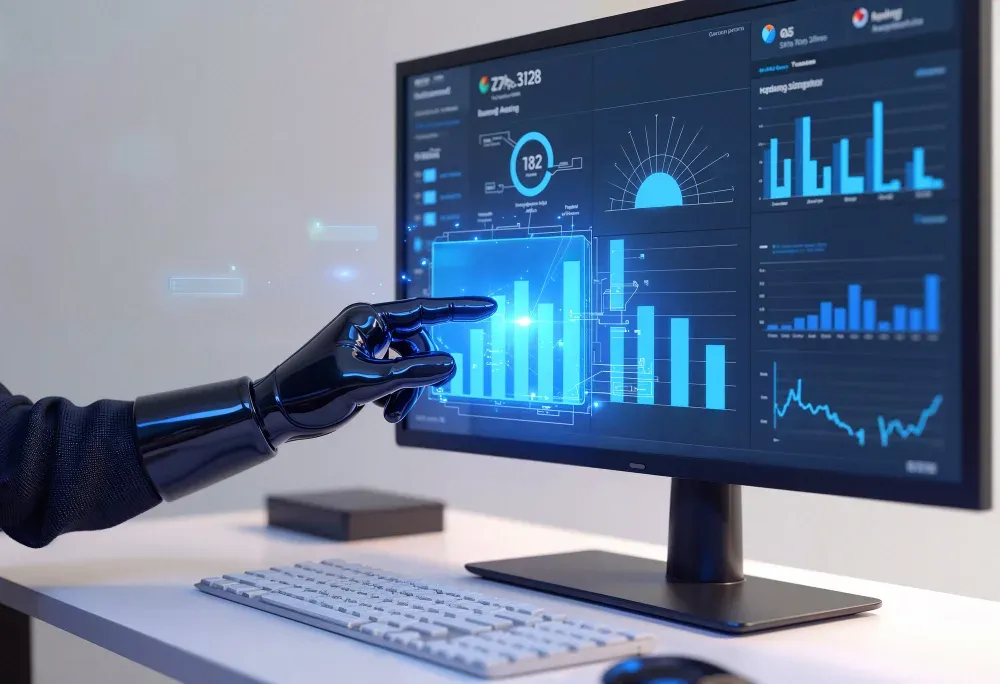Artificial Intelligence (AI) is redefining how investors make decisions. Once seen as futuristic, AI has now become one of the most powerful tools in finance — capable of analyzing thousands of data points, predicting price trends, and identifying opportunities in seconds.
Traditional stock analysis once depended on human judgment and experience. Now, AI can process vast amounts of financial and sentiment data faster, more accurately, and without emotional bias.
This article breaks down what AI stock analysis is, how it works, and how investors can use it wisely — along with its key advantages and limitations.
What Is AI Stock Analysis?
AI stock analysis uses artificial intelligence algorithms to study financial data, price movements, and news sentiment to support investment decisions.
According to Investopedia, AI converts massive “big data” into insights that investors can act on. It learns from past market behavior, identifies patterns, and provides buy or sell signals based on statistical probability.
There are two main types of AI applications in investing:
- Automated AI Trading – AI executes trades automatically using algorithms that respond to market movements in real time.
- AI-Assisted Analysis – AI provides insights, forecasts, and risk assessments that help investors make informed choices.
How AI Works in Stock Analysis
AI combines several technologies — machine learning, natural language processing (NLP), and deep learning — to interpret and predict market trends. Here’s how it’s applied in modern investing:
1. Historical Pattern Recognition
AI scans millions of price data points to identify patterns that often precede rallies or corrections.
2. Market Sentiment Tracking
Using NLP, AI analyzes news articles, social media, and earnings reports to detect positive or negative sentiment toward a company or sector.
3. Anomaly Detection
AI flags unusual trading volumes or price movements that may signal manipulation or large institutional moves — things human traders often miss.
4. Predictive Analytics
Machine learning models predict short-term market trends by combining both technical and fundamental indicators.
5. Portfolio Optimization
AI builds balanced portfolios by studying asset correlations, volatility, and investor risk tolerance to enhance diversification.
Real-World AI Applications in Investing
AI is already deeply integrated into global trading platforms. Some of the most notable use cases include:
- Kensho (S&P Global) – Used by major institutions to connect macroeconomic data with asset performance.
- Trade Ideas – Employs an AI engine called Holly to deliver daily trading strategies with high accuracy.
- Bloomberg Terminal – Uses AI to analyze thousands of news headlines in real time and assess sentiment toward listed companies.
- Upstox & Alpaca – Retail platforms that provide personalized insights and automated trading recommendations powered by AI.
- ChatGPT and Large Language Models (LLMs) – Now used by investors to interpret financial reports, summarize earnings calls, and craft strategies faster.
Benefits of Using AI in Stock Analysis
1. Lightning-Fast Processing
AI can process as much information as thousands of analysts combined — in just a few seconds.
2. Emotional Neutrality
AI doesn’t experience fear or greed, two emotions that often derail rational investment decisions.
3. Continuous Learning
AI models constantly refine themselves, improving prediction accuracy with every new data point.
4. Real-Time Market Response
AI reacts instantly to breaking news and market shifts, providing timely trading signals and alerts.
5. Pattern Recognition Beyond Human Capability
AI identifies complex, multi-variable relationships that human analysts may overlook — such as the interplay between volume, volatility, and sentiment.
Risks and Limitations of AI Investing
Despite its sophistication, AI investing comes with important caveats:
- Dependence on Past Data – AI models are only as good as their training data. They may fail to predict black swan events like pandemics or geopolitical shocks.
- Lack of Context – AI doesn’t fully understand the social or psychological factors that influence investor behavior.
- Overfitting Risk – Some models perform well historically but fail under new market conditions.
- Black-Box Problem – Many AI systems don’t explain how they reach conclusions, reducing transparency.
- Cost and Accessibility – Advanced AI infrastructure can be expensive for small investors or institutions.
How Retail Investors Can Use AI Wisely
AI is most effective when used as a decision-support tool, not a full replacement for human judgment. Here are some smart ways to incorporate AI into your investing process:
- Use it for insight, not impulse. Let AI assist your analysis, but always validate its recommendations with fundamental research.
- Pick regulated platforms. Choose trading apps or brokers with credible AI systems and transparent data practices.
- Understand the logic behind the tool. Know what the AI model measures and how it interprets data.
- Prioritize security. Ensure the platform protects your financial data with encryption and privacy compliance.
- Combine AI with long-term strategies. Use AI insights to strengthen structured approaches like dollar cost averaging (DCA) or portfolio rebalancing.
The Bottom Line
AI stock analysis represents a major leap in how investors study and understand markets. It can process huge datasets, detect trends, and execute trades faster than any human — offering both efficiency and precision.
Yet, technology alone isn’t a silver bullet. The best investors use AI as an extension of their strategy — blending machine precision with human context, patience, and long-term discipline.
In short, AI can make you a smarter investor — but only if you stay in control of the decisions it helps you make.
FAQ
1. What is AI in stock analysis?
→ It’s the use of artificial intelligence to analyze financial data, identify patterns, and help investors make better trading decisions.
2. Can AI replace human analysts?
→ Not entirely. AI offers speed and accuracy, but human insight is still essential to interpret context and market sentiment.
Disclaimer:
Gotrade is the trading name of Gotrade Securities Inc., which is registered with and supervised by the Labuan Financial Services Authority (LFSA). This content is for educational purposes only and does not constitute financial advice. Always do your own research (DYOR) before investing.




